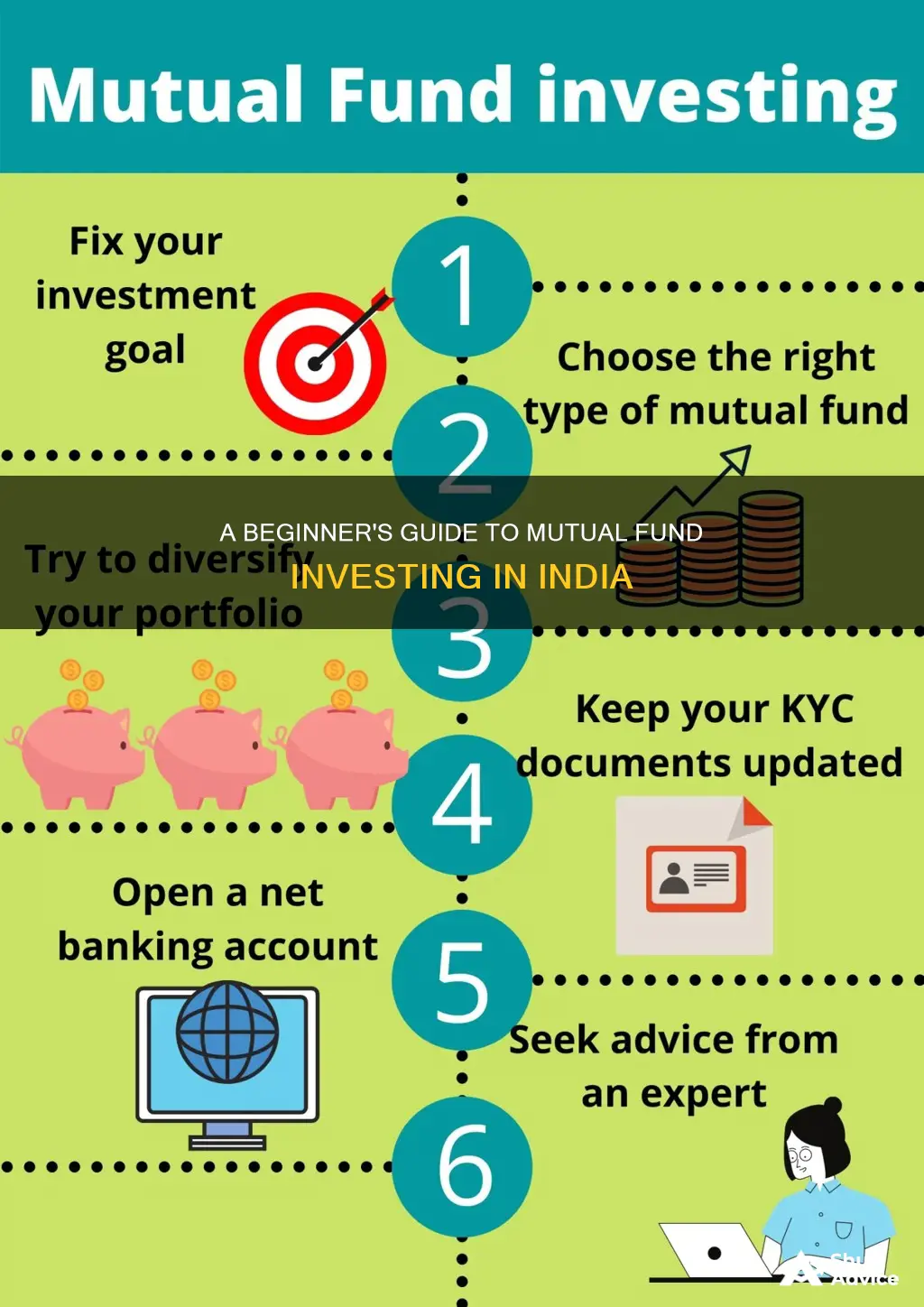
Investing in mutual funds in India is a smart way to grow your money. It is an investment vehicle where multiple investors pool their funds, which are then managed by a fund manager and invested across various asset classes. Before investing, it is important to identify your purpose for investing, whether it is buying a house, a child's education, or retirement. You should also be aware of the different types of mutual funds available, such as equity funds, debt funds, and hybrid funds, and the risks associated with each. To invest in mutual funds, you can either invest online through the fund house's website or app, or offline directly with the fund house or through a broker. Additionally, you will need to complete the Know Your Customer (KYC) process and provide the necessary documents, such as a cancelled cheque leaf and passport-sized photograph.
| Characteristics | Values |
|---|---|
| Minimum Investment Amount | ₹500 as a lump sum and ₹500 for a monthly SIP |
| Investment Options | Online, Offline Directly with Fund House, Offline through a Broker, or through a Financial Intermediary |
| Investment Types | Lump Sum or SIP |
| KYC Requirements | Completed KYC form, Aadhaar, PAN, passport, and other photo IDs |
| Other Requirements | Cancelled cheque leaf, passport-sized photograph |
What You'll Learn

Understanding risk and returns
Risk and return are two sides of the same coin. Greater risks are correlated with bigger potential profits, while safer (lower-risk) investments tend to yield smaller returns. When selecting an investment option, investors consider both the possible returns and the dangers associated with a venture.
There are several types of risks and returns that investors should be aware of:
- Market risk: Also known as systemic risk, it results from market-related variables such as changes in interest rates, currency movements, and political and economic unrest.
- Specific risks: These are primarily associated with the business and can be managed by monitoring and diversifying investments.
- Credit risk: This is associated with the company's creditworthiness. A company with strong finances will be able to pay off its debts and fulfill its obligations, leading to a high credit rating. Declining financial health can lead to credit risk.
- Liquidity risk: This arises when a company can’t generate enough income to cover its costs and maintain sufficient working capital.
- Interest rate risk: Changes in market interest rates can impact a company's ability to borrow money.
- Inflation: Inflation erodes the value of future cash flows and safe investment options. It also affects the purchasing power of investors, reducing their net gains.
To make informed investment decisions, it is crucial to understand the dynamics of risk and return. By assessing the level of risk and potential return, investors can construct diversified portfolios aligned with their financial goals and risk tolerance.
- Diversification: Spreading investments across different asset classes, sectors, and geographic regions can help mitigate specific risks.
- Long-term perspective: Holding investments for longer periods can help balance out the impact of market fluctuations and improve overall returns.
- Regular review: Investors should periodically review their portfolio to identify underperforming investments and adjust their strategy accordingly.
- Risk profiling: Understanding one's risk tolerance through risk tolerance questionnaires and discussions with financial advisors can help construct a portfolio aligned with their comfort level.
- Asset allocation: Striking the right balance between equity and debt investments can help manage market risks and improve returns.
Auditing Your Investment Portfolio: A Comprehensive Guide
You may want to see also

Know Your Customer (KYC)
KYC compliance is mandated by the Prevention of Money Laundering Act, 2002, and its associated rules. The Securities and Exchange Board of India (SEBI) has prescribed specific requirements for financial institutions and intermediaries, including mutual funds, to know their customers. As a result, SEBI-registered intermediaries like mutual funds are required to conduct due diligence on customers by collecting specific documents, performing in-person verification, and obtaining photographs.
The Mutual Fund Industry has appointed CDSL Ventures Limited (CDSL), a subsidiary of Central Depository Services (India) Limited, to manage the KYC compliance procedure. Investors can submit their KYC Application Forms and supporting documents at CDSL's Points of Service (POS), and they will receive a KYC Acknowledgement. This acknowledgement must be submitted along with the investment application form to the chosen mutual fund. It is important to note that each joint holder in a mutual fund investment must be individually KYC compliant and provide their KYC Acknowledgement.
For Non-Resident Indians (NRIs) and Persons of Indian Origin (PIOs), the KYC process involves submitting a soft copy of the KYC form, along with necessary attested documents, either at the POS or to their representative or distributor. In addition to the passport copy, they must also provide a certified true copy of their overseas address and permanent address. If any documents are in a foreign language, they must be translated into English for submission. The requirements for PIOs are the same as for NRIs, with the additional requirement of submitting a certified true copy of the PIO Card.
It is important to note that KYC compliance is not limited to new investors but also extends to existing investors. From February 1, 2017, all new investors were required to mandatorily submit the CKYC form with their investment applications. Existing investors could continue investing without any changes; however, they must update their PAN details and complete the KYC process to avoid restrictions on future transactions.
The Central Know Your Customer (CKYC) initiative by the Government of India aims to streamline the KYC process across the financial sector. Investors only need to complete the CKYC process once and can then interact with various financial entities without repeating the KYC procedure. The Central Registry of Securitization Asset Reconstruction and Security Interest of India (CERSAI) manages the CKYC process and acts as a centralized repository of KYC records.
Saving Precedes Investing: The Foundation of Financial Planning
You may want to see also

Systematic Investment Plans (SIPs)
Here's how SIPs work:
- An investor chooses a mutual fund scheme that aligns with their financial goals and risk profile.
- They determine the frequency and amount of their SIP investments, which can be as low as Rs. 100 per month.
- The investor sets up automatic debits from their bank account, so the SIP amount is deducted and invested in the chosen mutual fund scheme at the predetermined intervals.
- The mutual fund allocates units to the investor's account based on the fund's Net Asset Value (NAV).
- Additional units are added to the investor's account with each investment, depending on the market rate.
- The investor can choose to receive returns at the end of the SIP's tenure or at periodic intervals.
There are several benefits to investing in SIPs:
- Disciplined Investment: SIPs promote financial discipline by automating investments and helping investors avoid the temptation of timing the market.
- Rupee Cost Averaging: By investing a fixed amount regularly, investors can take advantage of market fluctuations and lower their average cost per unit.
- Compounding Returns: SIPs allow investors to benefit from compounding returns, as the returns generated are reinvested over time.
- Flexibility: SIPs offer flexibility in terms of investment amounts and frequency, allowing investors to adjust their contributions based on their financial situation.
- Long-term Wealth Creation: SIPs are designed for long-term wealth creation, helping investors achieve significant returns over an extended period through consistent and disciplined contributions.
- Professional Fund Management: SIP investments are managed by professional fund managers who make informed decisions based on market conditions and the fund's objectives.
Overall, Systematic Investment Plans (SIPs) are a popular and effective way to invest in mutual funds in India, offering investors a disciplined, flexible, and convenient approach to building long-term wealth.
The Future of Investment Management: 2030 Vision
You may want to see also

Tax Regime for Mutual Funds
Mutual funds are taxed based on the holding period and the type of mutual fund. The holding period is the time between the date of purchase and the date of sale of the mutual fund units. The longer the holding period, the less tax you are liable to pay.
Mutual funds offer returns in the form of dividends and capital gains. Dividends are a part of the profit distributed among investors by mutual fund houses. Capital gains are the profits realised by investors if the selling price of the security held by them is greater than the purchase price. Both dividends and capital gains are taxable in the hands of investors of mutual funds.
Taxation of Dividends
Dividends offered by any mutual fund scheme are taxed in the classical manner. That is, dividends received by investors are added to their taxable income and taxed at their respective income tax slab rates.
Taxation of Capital Gains
The taxation rate of capital gains depends on the holding period and type of mutual fund. Capital gains realised on selling units of mutual funds are categorised as follows:
- Short-term capital gains: Shorter than 12 months
- Long-term capital gains: 12 months and longer
The short-term and long-term capital gains offered by mutual funds are taxed at different rates.
#### Taxation of Capital Gains of Equity Funds
Equity funds are those mutual funds where more than 65% of the total fund amount is invested in equity shares of companies. You realise short-term capital gains if you redeem your equity fund units within a year. These gains are taxed at a flat rate of 15%, irrespective of your income tax bracket.
You make long-term capital gains on selling your equity fund units after holding them for over a year. These capital gains of up to Rs 1 lakh a year are tax-exempt. Any long-term capital gains exceeding this limit attract LTCG tax at 10%, without indexation benefit.
#### Taxation of Capital Gains of Debt Funds
Debt funds are those mutual funds whose portfolio’s debt exposure is in excess of 65% and equity exposure is not more than 35%. Starting 1st April 2023, the debt funds will no longer receive indexation benefit and will be deemed to be short-term capital gain. Therefore, the gains from debt funds will now be added to your taxable income and taxed at the slab rate.
#### Taxation of Capital Gains of Hybrid Funds
The rate of taxation of capital gains on hybrid or balanced funds depends on the equity exposure of the portfolio. If the equity exposure exceeds 65%, then the fund scheme is taxed like an equity fund. If the equity exposure is 65% or less, then the rules of taxation of debt funds apply.
#### Taxation of Capital Gains When Invested Through SIPs
Systematic investment plans (SIPs) are a method of investing in mutual funds. You purchase a certain number of mutual fund units through every SIP instalment. The redemption of these units is processed on a first-in-first-out basis.
Suppose you invest in an equity fund through an SIP for one year, and you decide to redeem your entire investment after 13 months. In that case, the units purchased first through the SIP are held for the long term (over one year), and you realise long-term capital gains on these units. If the long-term capital gains are less than Rs 1 lakh, then you don’t have to pay any tax.
However, you make short-term capital gains on the units purchased through the SIPs from the second month onwards. These gains are taxed at a flat rate of 15% irrespective of your income tax slab. You will have to pay the applicable cess and surcharge on it.
Securities Transaction Tax (STT)
Apart from the tax on dividends and capital gains, there is another tax called the Securities Transaction Tax (STT). An STT of 0.001% is levied by the government when you decide to buy or sell mutual fund units of an equity fund or a hybrid equity-oriented fund. There is no STT on the sale of debt fund units.
ERP Modules: Unlocking Investment Management Potential
You may want to see also

How to withdraw your money
Withdrawing money from mutual funds in India can be done in several ways, depending on your preference and the type of fund you have selected. The process is relatively simple, and you can choose to redeem your cash partially or as a full withdrawal. Here is a step-by-step guide on how to withdraw your money from mutual funds in India:
Understand the Types of Mutual Fund Redemptions:
- Partial Withdrawal: Redeem only a portion of your total investment while keeping the remaining amount invested. This option is useful when you need funds for specific expenses without liquidating your entire investment.
- Full Withdrawal: Liquidate your entire investment in the mutual fund scheme. This option is typically chosen when you need access to all your funds for significant expenses, financial goals, or portfolio restructuring.
Choose a Withdrawal Method:
- Through an Asset Management Company (AMC) or Transfer Agent: Visit the website or branch office of the AMC or the registrar and transfer agent (RTA) of your mutual fund. Submit an online or offline redemption request. You will need your folio number, PAN, and bank details. The redemption amount will be credited to your bank account within a few days, depending on the fund type.
- Through a Broker, Distributor, or Agent: If you invested through a broker, distributor, or agent, you can request a redemption through them. They will process your request, and the amount will be credited to your account.
- On Your Own (Online): If you invested directly without an intermediary, visit the mutual fund's website and log in with your credentials. Select the fund and the number of units you want to redeem, then confirm your request. The redemption amount will be credited to your bank account within a few days, depending on the fund type.
- Trading or DEMAT Account: If you use a Trading or DEMAT Account to invest in Mutual Fund schemes, access your account, choose the withdrawal amount, and submit a request. Once verified, the redemption will be performed, and the money will be transferred to your bank account.
- Through a Bank: Contact your bank and request a withdrawal from your mutual fund investment. They will guide you through their specific process.
Submit a Redemption Request:
Provide details such as the amount or number of units you wish to withdraw. The fund house will verify your holdings and the applicable terms and conditions, including checking for lock-in periods or exit loads. The withdrawal process typically takes a few business days and may vary depending on the fund house and the type of mutual fund.
Consider the Tax Implications:
Capital gains tax applies to mutual fund returns. Understand the tax implications of your withdrawal, as tax rates differ based on the duration of your investment (short-term vs. long-term) and the fund type (equity vs. debt). Consult a tax advisor to make informed decisions.
Understand the Timing of Your Withdrawal:
While you can withdraw money from most mutual funds at any time, some funds have a lock-in period during which you cannot redeem your units. For example, tax-saving funds or ELSS (Equity Linked Savings Scheme) have a three-year lock-in period. Plan your withdrawals accordingly.
Stay Informed About Exit Loads:
Some mutual funds charge an exit load, a fee applied when you withdraw your money before a specified period. For example, certain funds may charge a 1-2% exit load if you redeem your investment within a particular time frame. Exit loads reduce your net redemption value, so consider this when planning your withdrawals.
Monitor Your Investment Holdings:
After submitting your redemption or withdrawal request, you will receive updates on your transaction status. The net proceeds, after applicable deductions, will typically be credited to your designated bank account within three business days.
Remember to consider your financial goals, potential tax implications, and market conditions when deciding to withdraw your money from mutual funds in India.
Morgan Stanley: Leading the Way in Investment Management
You may want to see also







